Crafting a baby blanket is a labor of love, a tangible expression of care and warmth for a newborn, or a cherished gift for expecting parents.
The process involves not just the selection of soft, baby-friendly fabrics but also the careful consideration of design, stitching techniques, and personalization.
Each step contributes to creating a unique and treasured keepsake, from choosing the right materials to adding delicate embellishments.
In this guide, we will explore the art of making a baby blanket, offering tips, techniques, and creative ideas to help you craft a blanket that not only comforts a baby but also symbolizes your affection and craftsmanship.
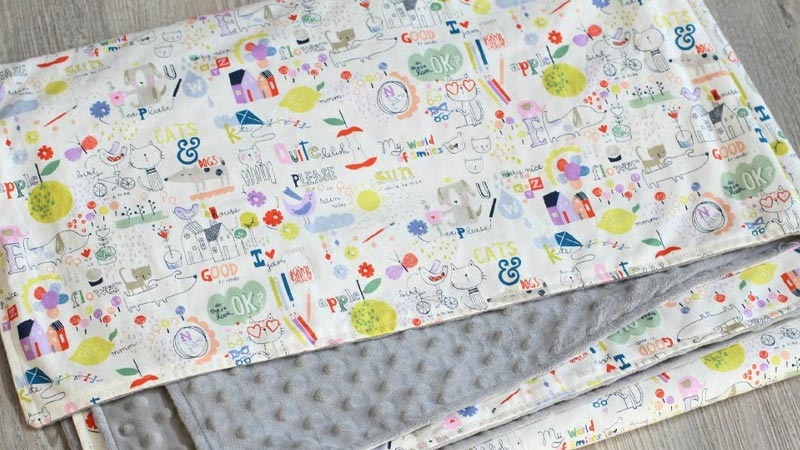
How to Make a Baby Blanket?
Making a baby blanket is a wonderful way to create a special, handmade gift that will be cherished for years to come. Whether you’re an experienced crafter or a beginner, this project can be both enjoyable and rewarding.
Here’s a step-by-step guide on how to make a baby blanket:
Materials Needed
- Fabric.
- Scissors.Measuring Tape or Ruler.
- Sewing Machine.
- Thread.
- Pins.
- Iron and Ironing Board.
Steps:
Select Your Fabric
Start by selecting a soft, baby-friendly fabric. Consider the parents’ preferences and the baby’s gender when choosing the color or pattern.
Fabrics like flannel, cotton, or Minky are great choices for their softness and durability. Ensure that the fabric is pre-washed to prevent any shrinkage or color bleeding after sewing.
Decide on Size
Think about the desired size of your baby blanket. Standard dimensions for baby blankets are approximately 36×36 inches for a square blanket or 30×40 inches for a rectangular one.
However, feel free to adjust these dimensions to your liking or based on the availability of your chosen fabric.
Cut the Fabric
Lay your selected fabric flat on a clean, smooth surface. Using a measuring tape or ruler, mark the dimensions you’ve decided on for your blanket. Carefully cut along these marks to create your fabric pieces.
If you’re working with multiple fabrics for a patchwork effect, cut them to the same size.
Arrange the Layers
When you’ve chosen to use different fabrics for your baby blanket, arrange them in the desired pattern or layout. Ensure that the right sides of the fabric pieces are facing each other. This will allow you to sew them together neatly.
Pin and Sew
With the fabric layers stacked correctly, use sewing pins to secure them together along the edges. Leave a small gap (approximately 4-6 inches) along one edge, which will be used to turn the blanket right side out later.
Use a sewing machine and an ½ inch seam allowance to sew around the edges, removing pins as you go. Make sure to reinforce the corners by sewing a few extra stitches at each corner.
Trim the Corners
When your baby blanket is a square, you can trim the corners diagonally, close to the stitching line. This reduces bulk in the corners and helps them appear crisp and well-defined when the blanket is turned right side out.
Turn the Blanket Right Side Out
Reach inside the gap that you left open and gently push out all the corners and edges to ensure they are fully turned right side out. Be careful not to use too much force to avoid damaging the fabric or the stitches.
Press Seams
Press all the seams on your baby blanket using an iron set to the appropriate temperature for your fabric. This step gives your blanket a polished and professional finish. Be thorough in pressing all edges and corners.
Close the Gap (Hand-Sewing)
When you’ve chosen to hand-sew your baby blanket, use a slip stitch or whipstitch to neatly close the gap you left open for turning. Ensure that your stitches are secure and inconspicuous.
Topstitch
Consider topstitching around the edges when adding extra stability and a finished look to your baby blanket. This step is optional but can enhance the appearance and durability of your blanket.
Wash and Iron
To make your baby blanket softer, consider giving it a gentle wash. Follow the care instructions for the fabric you used. After washing, iron the blanket again to ensure it lays flat and maintains its shape.
Personalize
For an extra special touch, consider personalizing the baby blanket. Using fabric markers or embroidery thread, you can add embroidery, appliqué, or even the baby’s name. Personalization adds a unique and sentimental aspect to your handmade gift.
How Big Should a Baby Blanket Be?
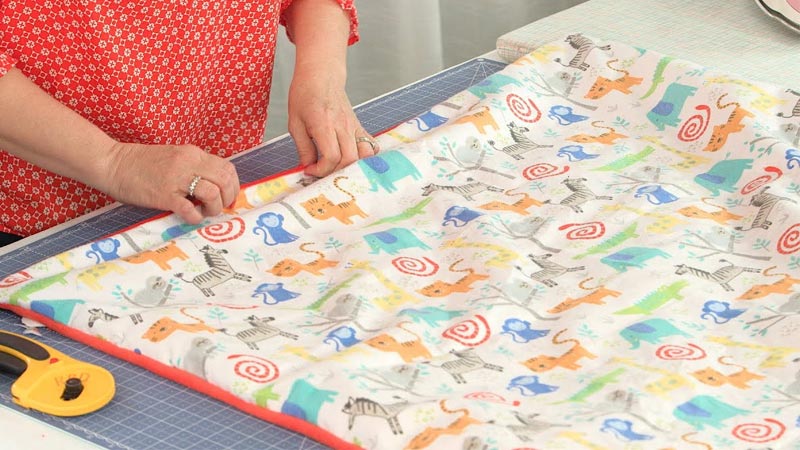
The size of a baby blanket can vary depending on personal preference and its intended use. However, there are some common dimensions that you can consider as a starting point.
Here are some typical sizes for baby blankets:
Receiving Blanket
These are usually the smallest baby blankets, measuring around 28 inches by 34 inches (71 cm x 86 cm). They are designed for wrapping newborns and providing a sense of security.
Standard Baby Blanket
A standard baby blanket is often around 30 inches by 40 inches (76 cm x 102 cm). This size is suitable for swaddling, covering a baby in a stroller or car seat, or using as a playmat.
Crib Blanket
Crib blankets are typically larger, measuring about 36 inches by 52 inches (91 cm x 132 cm). They are designed to fit inside a crib and provide warmth and comfort while a baby sleeps.
Toddler Blanket
As a baby grows into a toddler, you may opt for a slightly larger blanket, such as 40 inches by 60 inches (102 cm x 152 cm). Toddler blankets are versatile and can be used for both crib bedding and as a larger cover.
Swaddle Blanket
Swaddle blankets are often square and range in size from 40 inches by 40 inches (102 cm x 102 cm) to 47 inches by 47 inches (119 cm x 119 cm).
They are specifically designed for swaddling newborns tightly to help them sleep better.
Larger Throws
Some people prefer to make baby blankets larger, closer to the throw blanket size, which can be around 50 inches by 60 inches (127 cm x 152 cm). This size provides more room for growth and versatility as the child ages.
Variations on Baby Blanket Making
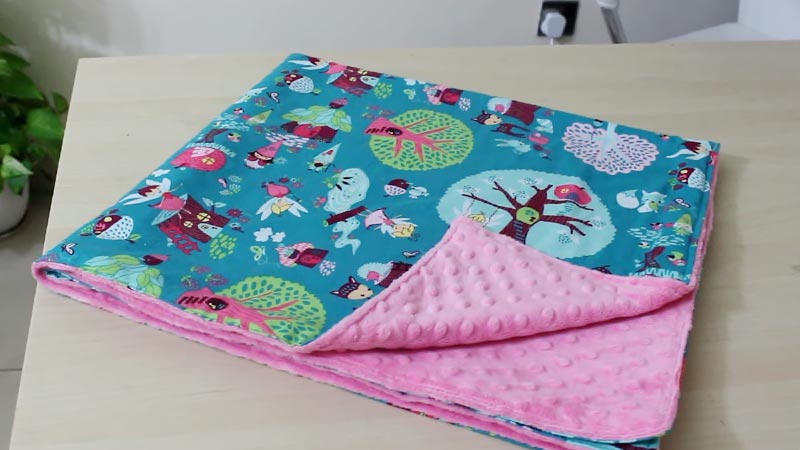
Creating a baby blanket offers endless opportunities for creativity. Here are some exciting variations on baby blanket making that you can explore to make your gift truly unique and special:
Patchwork Quilt
Crafting a patchwork quilt involves sewing small fabric squares or rectangles together to create a visually striking and unique design.
This technique allows you to mix and match various patterns, colors, and textures, resulting in a beautiful mosaic effect that will captivate both parents and babies alike.
Embroidered Keepsake
Elevate your baby blanket with the art of embroidery. This technique adds a personalized touch that can become a cherished keepsake.
Embroidery brings an extra layer of sentimentality to the gift, whether it’s the baby’s name, birthdate, or a heartfelt message.
Striped or Chevron Pattern
Experimenting with stripes or a chevron pattern involves sewing together strips of contrasting fabrics.
This contemporary design choice adds a dynamic visual element to the blanket, allowing you to play with different color combinations and create a modern, stylish look.
Rag Quilt
The rag quilt technique results in a cozy and textured baby blanket. You create a rustic, tactile appeal by sewing fabric squares with exposed seams.
As the blanket is used and washed, the edges will fray, adding to its charm and softness over time.
Knit or Crochet Blanket
Knitting or crocheting a baby blanket offers a warm, handmade touch. Choose soft, baby-friendly yarn and explore different stitches and patterns to create a one-of-a-kind blanket.
A hand-knit or crocheted blanket’s intricate texture and warmth provide a comforting embrace for the baby.
Faux Fur Blanket
Opt for a luxurious and ultra-soft baby blanket by using faux fur fabric. This choice provides exceptional warmth and a plush feel that will keep the baby snug and comfortable. It’s a perfect option for creating a stylish and indulgent blanket.
Matching Accessories
Consider going the extra mile by creating coordinating accessories alongside the baby blanket.
Crafting matching burp cloths, bibs, or stuffed animals adds an extra layer of thoughtfulness to the gift set. This way, the baby can enjoy a cohesive and beautifully crafted ensemble.
Photo Blanket
Incorporating photos into the blanket design creates a truly special keepsake. Use photo transfer techniques to embed images onto fabric or create a quilt with photo-printed fabric squares.
This personalized touch adds sentimental value and creates a visual story for the baby to enjoy as they grow.
Tied-Fringe Blanket
Design a quick and easy baby blanket by making a tied-fringe blanket. By cutting small slits along the edges of the fabric and tying the fringes together, you create a decorative border.
This approach adds visual interest and provides a tactile element that can engage the baby’s senses.
Heirloom Blanket
Transforming vintage linens, lace, or cherished clothing items into a sentimental heirloom baby blanket adds a touch of history and nostalgia to your gift.
This approach breathes new life into treasured fabrics, creating a unique and deeply meaningful keepsake for the family.
Custom Appliqué
Adding fabric appliqués in the shape of animals, letters, or symbols can give your baby blanket a distinctive and playful look. Use contrasting or complementary fabrics to create eye-catching designs that captivate the baby’s imagination.
Techniques for Making the Baby Blanket More Unique
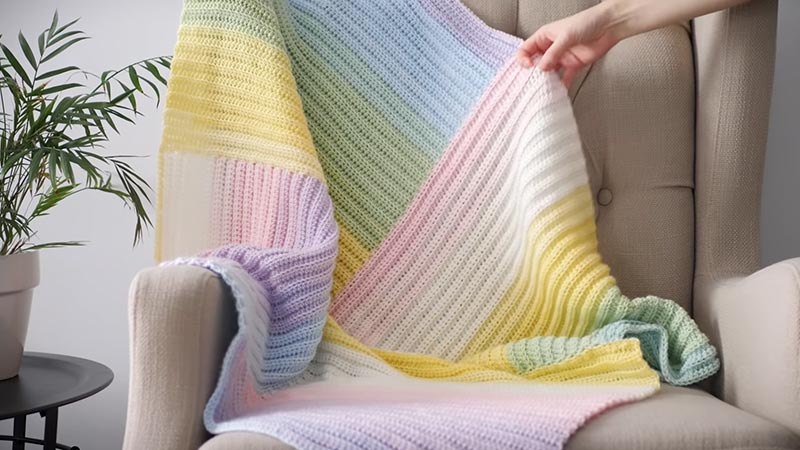
Making a baby blanket more unique involves adding personal touches, creative techniques, and thoughtful details that set it apart from store-bought options.
Here are some techniques and ideas to make your baby blanket stand out:
Tassel Embellishments
Add tactile elements by incorporating braids or tassels along the blanket’s edges. This provides a decorative touch and gives the baby something to explore and interact with.
Incorporate Pockets
Sew pockets onto the blanket where small toys, pacifiers, or keepsakes can be stored. This practical addition adds an extra layer of functionality to the blanket, making it a versatile and thoughtful gift.
Ribbon or Lace Accents
Enhance the edges of the blanket by attaching ribbons or lace trims. This delicate touch adds a touch of elegance and femininity, elevating the overall aesthetic.
Quilted Piping or Binding
Incorporate quilted piping or binding along the blanket’s edges for a polished finish.
This provides structural integrity and adds a refined touch, highlighting the craftsmanship.
Cable or Lace Knitting Patterns
When you’re knitting the blanket, explore cable or lace knitting patterns. These techniques create intricate and visually striking textures, adding depth and dimension to the blanket’s design.
Color Gradients or Ombre Effect
Play with color gradients or create an ombre effect by using varying shades of a single color. This creates a visually stunning transition and adds a modern and artistic touch to the blanket.
Photo Transfer
Use photo transfer techniques to incorporate images onto the fabric. These could be pictures of the baby, family members, or special moments, creating a sentimental and visually engaging design that tells a story.
Customized Binding
Add a unique touch by using a custom-made binding for the blanket’s edges. This could be a contrasting fabric, a personalized ribbon, or even a hand-stitched pattern, providing a distinctive finishing touch.
Fabric Collage Letters or Shapes
Create letters, shapes, or motifs using a fabric collage technique and attach them to the blanket’s surface. This personalization adds a playful and customized element, making the blanket truly special and memorable.
Tips for Making a Baby Blanket
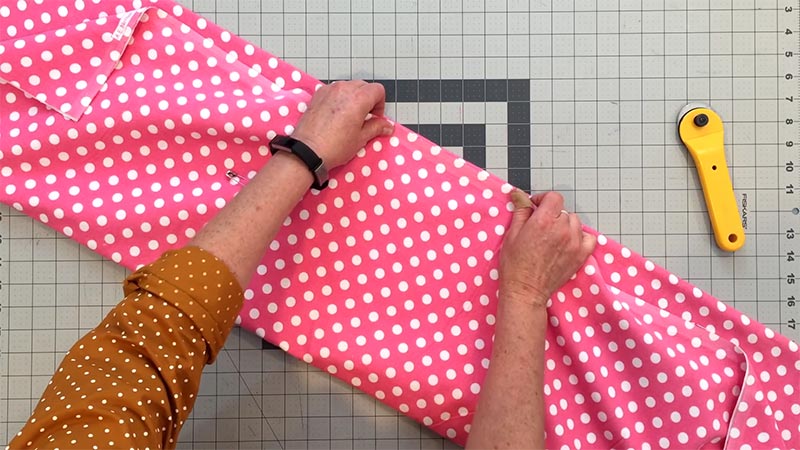
Creating a baby blanket can be a rewarding and thoughtful endeavor. Here are some helpful tips to consider when making a baby blanket:
Choose Baby-Friendly Fabrics
Selecting the right fabric is crucial for a comfortable and safe baby blanket. Look for materials that are soft, hypoallergenic, and breathable.
Fabrics like flannel, cotton, and Minky are excellent choices. Ensure that the fabric is of high quality and has no rough or scratchy textures.
Select Age-Appropriate Materials
When you’re adding embellishments, like buttons or ribbons, make sure they are age-appropriate and securely attached. Avoid small parts that could be a choking hazard for babies.
Opt for larger, securely sewn-on decorations, or consider using fabric paint or appliqué for added designs.
Pre-Wash Your Fabric
Before you start cutting and sewing, it’s important to pre-wash your chosen fabric. This removes any sizing or chemicals that may be present. It also helps to prevent the finished blanket from shrinking or puckering after washing it.
Use High-Quality Thread
Select a high-quality, baby-safe thread that complements your fabric. Ensure it’s durable and won’t easily fray or break during the sewing process. Depending on your design, the thread color should blend well with the fabric or provide a nice contrast.
Plan the Size
Consider the purpose of the blanket when determining its size. A receiving blanket (around 28×34 inches) is perfect for swaddling or covering a baby in a car seat.
A standard baby blanket (30×40 inches) provides versatility for various uses. Crib blankets (36×52 inches) are meant for use inside the crib. Adjust the size to your preference and intended use.
Invest in Good Scissors
High-quality fabric scissors are a must-have. Sharp, precise scissors ensure clean cuts and make the sewing process much smoother. Dull scissors can result in uneven edges and may even damage the fabric.
Consider Seam Allowance
When sewing the blanket’s edges, maintain a consistent seam allowance (usually between ¼ to ½ inch). This ensures that your stitches are even and secure. A consistent seam allowance also helps in achieving a neat and professional finish.
Test Sewing Machine Tension
When you’re using a sewing machine, take a moment to test the tension on a scrap piece of fabric before you start sewing the blanket. Proper tension prevents stitches from being too loose or too tight, ensuring a clean and even finish.
Press Seams
As you sew, periodically use an iron and ironing board to press seams flat. This step is crucial for achieving a polished and professional look.
Pressing the seams also helps to set them in place, creating a clean and neat appearance.
Practice Your Stitching
When you’re new to sewing, take some time to practice your stitching on scrap fabric.
Familiarize yourself with the machine’s settings and test different stitch patterns. This practice will help you gain confidence and improve the quality of your stitches.
FAQs
What are the best fabrics for a baby blanket?
The best fabrics for a baby blanket are soft, breathable, and hypoallergenic. Consider using flannel, cotton, or minky materials for a comfortable and safe blanket.
Do I need to pre-wash the fabric before making the blanket?
Yes, it’s recommended to pre-wash the fabric to remove any sizing or chemicals. This helps prevent shrinkage or color bleeding after the blanket is made.
What size should I make the baby blanket?
The size of the baby blanket depends on its intended use. Common sizes include receiving blankets (28×34 inches), standard baby blankets (30×40 inches), and crib blankets (36×52 inches).
What sewing techniques are best for a baby blanket?
Simple, straight-line stitches using a sewing machine or hand-sewing are commonly used for baby blankets.
How can I personalize the baby blanket?
You can personalize the baby blanket by adding embroidery, fabric paint, or appliqué.
Wrap Up
In crafting a baby blanket, attention to detail and choice of materials are paramount. Selecting soft, baby-friendly fabrics ensures comfort and safety.
Careful stitching, with consideration of seam allowance, contributes to a polished finish. Personal touches like embroidery or appliqué add a unique, sentimental element.
Pre-washing fabrics and using high-quality thread help maintain the blanket’s integrity over time. Safety precautions, including secure embellishments and age-appropriate materials, ensure the baby’s well-being.
By following these steps, you create a cherished keepsake, offering warmth and comfort and a piece of handmade love for the little one to cherish.
Leave a Reply